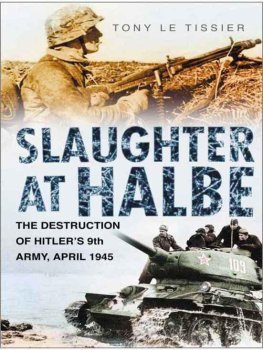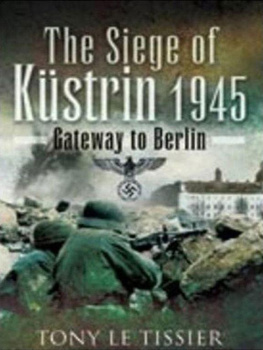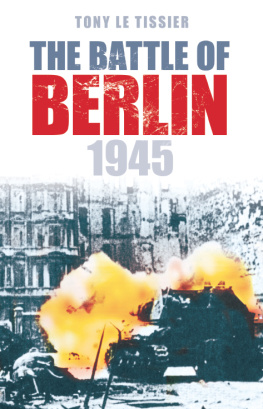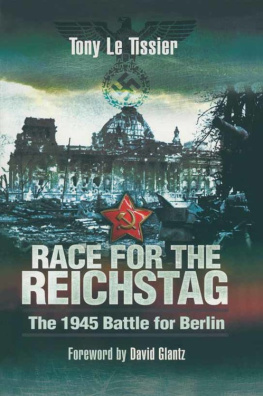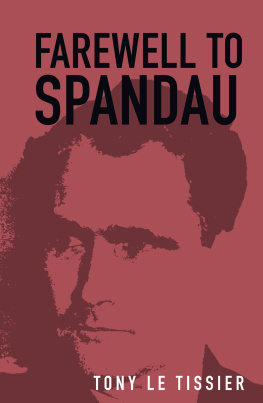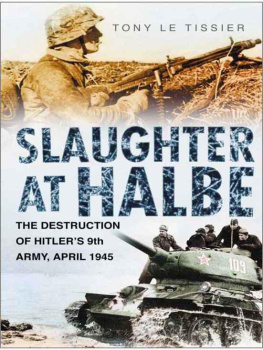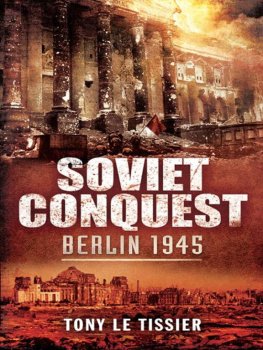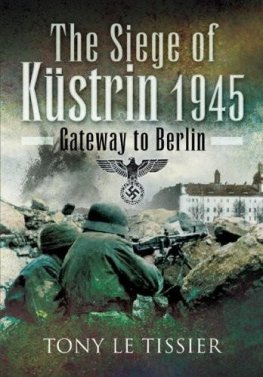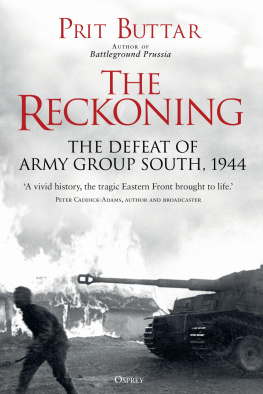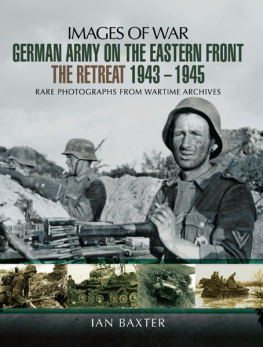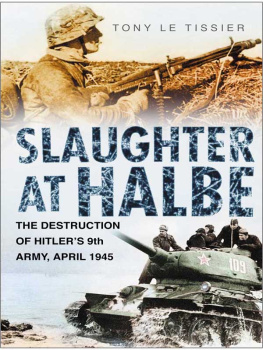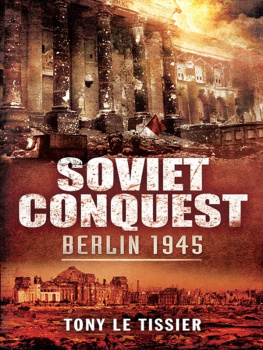Tony Le Tissier
SLAUGHTER AT HALBE
THE DESTRUCTION OF HITLERS 9TH ARMY
| A | Army |
| Arty | Artillery |
| B/Bde | Brigade |
| BF/Bye Fr | Byelorussian Front |
| C | Corps |
| D | Division |
| Elms | Elements |
| FWL | Forest Wardens Lodge |
| G/Gds | Guards |
| GCC | Guards Cavalry Corps |
| Gp | Group |
| Gr | Grenadier |
| Grn | Garrison |
| How | Howitzer |
| HQ | Headquarters |
| Hy | Heavy |
| ID | Infantry Division |
| Lt | Light |
| M/Mech | Mechanized |
| Mor | Mortar |
| Mtn | Mountain |
| Pol | Police |
| Pz | Panzer |
| SA | Shock Army |
| R | Rifle |
| Regt | Regiment |
| UF/Ukr Front | Ukrainian Front |
| V | Volunteer |
Halbe, a small village of about 400 inhabitants in the Spreewald forests south of Berlin, was the eye of the needle through which, in late April 1945, the troops of the already defeated German 9th Army had to pass if they wished to escape Soviet captivity with a break-out to the west.
Some 40,000 people, soldiers and civilians, are said to have been killed in this tragic episode. Their story deserves to be told.
The increasingly vicious and destructive manner in which the war on the Eastern Front had been conducted by both sides left those German soldiers with experience of it in no doubt as to the kind of fate Soviet captivity would bring them, and provided a powerful incentive for engaging in this final desperate struggle to break out and seek captivity with the Western Allies.
Survivors accounts give a chaotic picture, suggesting a large-scale loss of command and control in the military system that is not fully borne out by the surprisingly large number that got through to achieve their aim, despite the horrific casualties suffered in the process. Nevertheless, that there were some serious basic defects at command level cannot be denied.
I have been persuaded to attempt a study of these events by Horst Wilke, who survived the ordeal as a signals sergeant and was at one time business manager of the Halbe Memorial Sponsor Club (Frderverein Gendenksttte Halbe e.V.), and gave me free access to the archives he had accumulated over the years. It was at this clubs annual gathering in 1996 that I had the pleasure of meeting one of his Red Army opponents, Harry Zvi Glaser, who had actually fought in Halbe itself, and was now being fted by his erstwhile enemies.
I am particularly indebted to my friends Dozent Dr Sc. Richard Lakowski and Oberst a. D. Dr Karl Stich, both military historians of the former German Democratic Republic, whose excellent work Der Kessel von Halbe 1945 Das letzte Drama has proved an invaluable guide.
My own archives resulting from previous studies of the 1945 battles in and around Berlin (see The Battle of Berlin 1945, updated by feedback from the German edition as Race for the Reichstag, and Zhukov at the Oder), plus individual accounts related in With Our Backs to Berlin and Death was our Companion, yielded a wealth of useful information. Among my sources, I would like to name Erwin Bartmann and Rudi Lindner, the latter an officer cadet in the break-out who later became a major-general in the East German Army, Helmut Jrisch and the late Rechtsanwalt Gnter G. Fhrling.
My thanks are also due to Lothar Schulze, who kindly allowed me the use of translations of the local eyewitness statements that he collated in his book Der Kessel HalbeRadeland, and for his warning concerning the lingering traces of falsification of local history by the East German government in honouring their liberators and attributing all blame and damage to the Fascist Wehrmacht.
One factor in this connection is the reluctance to accept the fact that so-called Seydlitz-Troops were used in combat by the Soviets during the Berlin Operation, for official documentary evidence has yet to be found in either former East German or Soviet archives to support this claim. Seydlitz-Troops was the name given by the Germans to those turncoat prisoners of war who worked for the Red Army against their former comrades. The name came from General Walter von Seydlitz-Kurzbach, who had been captured at Stalingrad and had later become Chairman of the Bund Deutsche Offiziere (League of German Officers) and Vice-Chairman of the Nationalkomitee Freies Deutschland (NKFD National Committee for a Free Germany), institutions set up by the Soviets, initially only for propaganda purposes. However, during the later stages of the war Seydlitz-Troops were also used to spy out German positions, issue false orders to retreating troops, and even engaged in combat under close Soviet supervision. General von Seydlitz totally disassociated himself from these activities, and was eventually exonerated by a West German court after the war.
I must also thank Rolf Kaim of the Kummersdorf Schiessplatz Museum for his assistance in my research, including locating the report by Willi Klr, and Werner Mihan for tracking down copies of the wartime maps of that area.
Above all, I am greatly indebted to the outstanding generosity of Wilhelm Tieke for allowing me to include translations of numerous survivors accounts taken from his book Das Ende zwischen Oder und Elbe.
To assist the reader with the course of events described, I have endeavoured to illustrate the various aspects of the action with a series of maps and drawings incorporating as many of the place-names mentioned in the text as was feasible. Reference to the maps on which these names appear will be found noted in bold type in the index.
I would like to thank the various individuals whose names appear in the photo captions for allowing me to use the related illustrations. Evgeni Bessonovs photos originally appeared in his book Tank Rider (Greenhill Books, 2003, ISBN 1-85367-554-7). All illustrations which are not specifically credited are from my own collection.
ONE
Preparing for Operation Berlin
21 APRIL 1999
When the Soviets launched Operation Berlin on 16 April 1945, Marshal Georgi Konstantinovitch Zhukovs 1st Byelorussian Front opposite Berlin, and Marshal Ivan Stepanovitch Konievs 1st Ukrainian Front further south, faced the German 9th Army on the Oder River and 4th Panzer Army on the Neisse River respectively in overwhelming force.
For this final assault on the Third Reich, the Soviets had mustered the last of their manpower to fill the establishments of these two army groups and to provide them with all the equipment and supplies they needed. Additionally, substantial artillery formations from the Stavka (General Staff) Reserve had been placed at their disposal for the initial breakthrough battle. Excluding reserves and rear area troops, these forces amounted to:
| - | 1st Byelorussian Front | 1st Ukrainian Front |
|---|
| Men & Women | 768,000 | 511,700 |
| Tanks | 1,795 | 1,388 |
| Self-propelled guns | 1,360 | 677 |
| Anti-tank guns | 2,306 | 1,444 |
| Field (76-mm+) | 7,442 | 5,040 |
| Mortars (88-mm+) | 7,186 |

